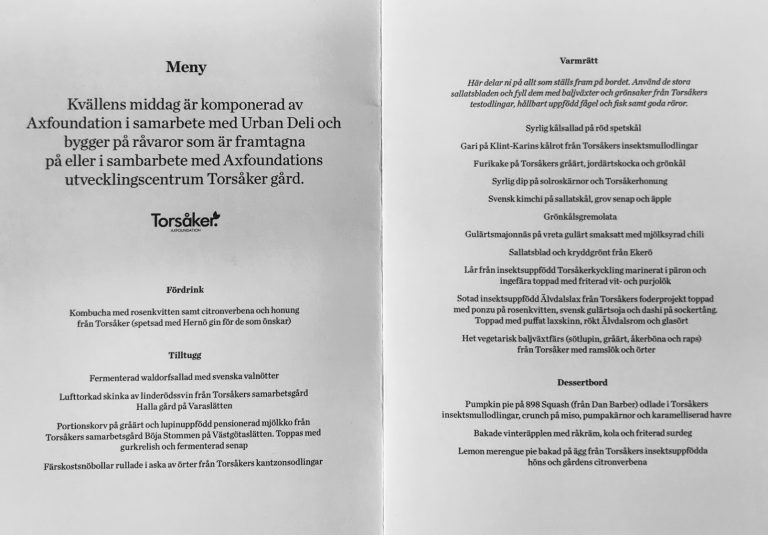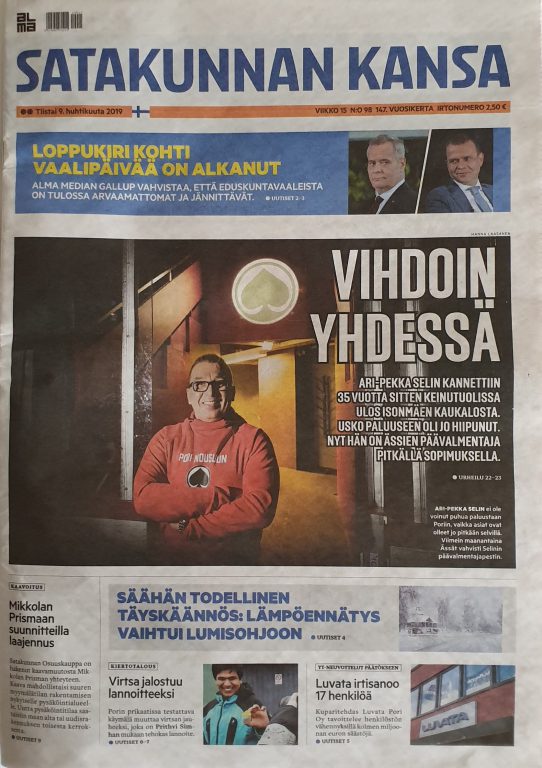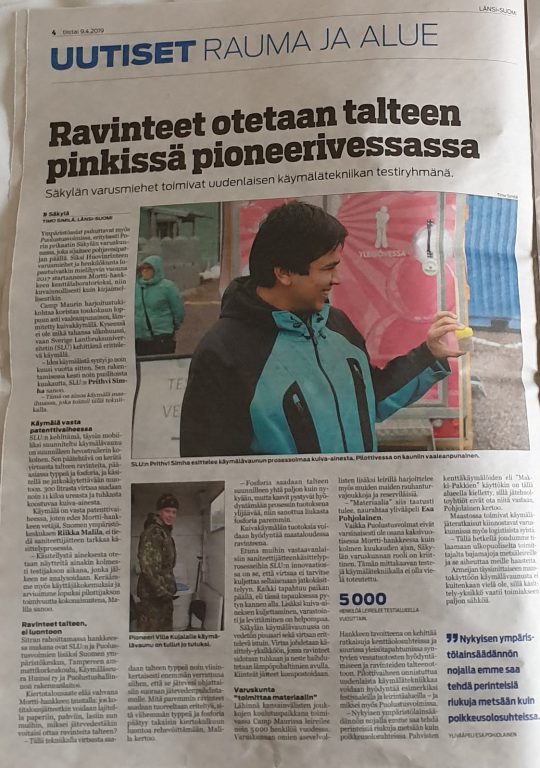Årets evenemang hade temat under ytan, och tog upp ett brett spektrum av intressanta ämnen, från djuphavsforskning till psykologin kring hur vi ser på och hanterar klimathotet. Vårt inspel syntes på menyn, då Axfoundation bjöd på sin vision av framtidens mat. Det bjöds på kålrot och pumpa, gödslad med frass (insektskompost) från våra fluglarver som utfodrats med livsmedelsavfall och till det serverades det både kyckling och regnbågslax som har fått insekter som sin huvudsakliga proteinkälla. Larverna som användes var uppfödda på återtaget bröd och grönsaksavfall från Sorunda grönskshallar.
Kretsloppsteknik at the Human Nature arranged by Axfoundation
This year’s event had the theme below the surface, and brought up a wide range of interesting topics; from deep-sea research to the psychology of how we look at and manage the threat of climate change. At dinner Axfoundation presented their vision of future food and that’s where we came into the picture. On the menu were cabbage and pumpkin fertilized with frass (insect compost) from our fly larvae reared on food waste, served with chicken and rainbow trout that had insects as their main protein source. The larvae used in the feed were reared on reclaimed bread and vegetable waste from Sorunda grönsakshallar.
Forskning kring urinsortering i finsk media
I samband med MORTTI-projektet testas vår grupps urinsorteringsteknologi i fält vid Björneborgs Brigads militärträningsbas i Finland. Tidigare under veckan deltog våra gruppmedlemmar Caroline Karlsson och Prithvi Simha tillsammans med MORTTIs partners i ett organiserat mediaevent med flera lokala och nationella mediakanaler. Klicka på länkarna nedan för att ta del av vad media tyckte om besöket och vårt toalettsystem.
YLE: På TV The soldier’s piss improves the world – dry urine is a good fertilizer & i tryck: https://yle.fi/uutiset/3-10730337
Maaseudun Tulevaisuus: The Defense Forces are trying to recover urine as fertilizer – In the Pori Brigade exercise area there is a Biomaja field toilet
Helsingin Sanomat: In Säkylä, the nutrients of the urine are preserved, with the aim of making urine fertilizer
Satakunnan Kansa: Converting soldiers’ urine into dry fertilizer powder – a Swedish invention that can come into play at festivals in the future
Verkkouutiset: The recycling of the officers’ urine is being tested
Länsi-Suomi: Army is testing a pilot toilet in Säkylä
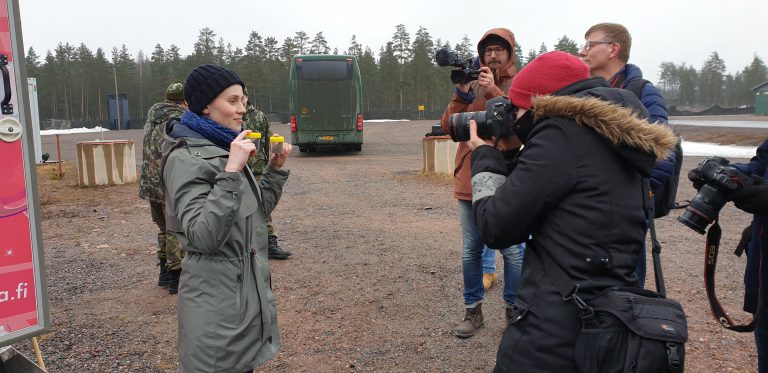
Caroline Karlsson showing the fertiliser end-product after urine drying to the media in Säkylä
Kontakt: Prithvi Simha
Från soldaturin till torr gödsel: Björneborgs Brigad, finska försvarsmakten
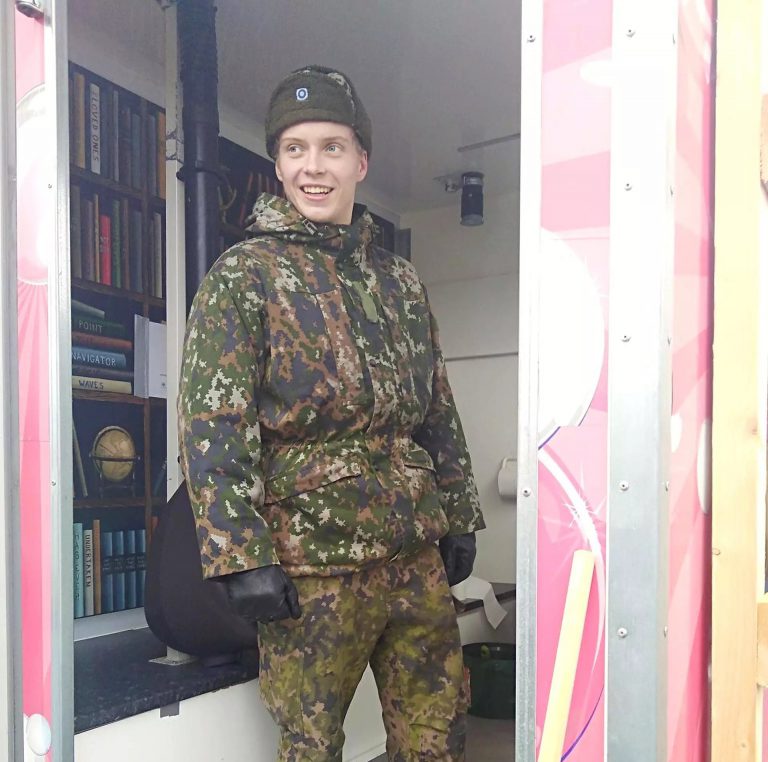
Pioneer Ville Kujala introduces the pilot system at the Säkylä garrison. PC: Käymäläseura Huussi
Den 8 april arrangerade MORTTI-projektets partners en mediadag för att uppmärksamma vårt projekt i Finland som har varit igång sedan första veckan av mars. Pilotprojektet, som pågår i tre månader, stabiliserar och torkar urin från soldater och skapar samtidigt under säkra förhållanden en torr gödsel i pulverform. Projektet testar urinsorteringsteknologin utvecklad av vår forskargrupp i fält. Caroline Karlsson och Prithvi Simha representerade Kretsloppsteknik på mediadagen.
Urine drying research featured in Finnish media
Within the MORTTI project, our group’s urine drying technology is being piloted at Pori Brigade’s military training site in Finland. Earlier this week, as part of an organised media day event, members of our group Caroline Karlsson and Prithvi Simha alongwith MORTTI project partners interacted with several local and national media outlets. Click below to read what the media thought of this visit and our toilet system.
YLE: On TV The soldier’s piss improves the world – dry urine is a good fertilizer & In Print https://yle.fi/uutiset/3-10730337
Maaseudun Tulevaisuus: The Defense Forces are trying to recover urine as fertilizer – In the Pori Brigade exercise area there is a Biomaja field toilet
Helsingin Sanomat: In Säkylä, the nutrients of the urine are preserved, with the aim of making urine fertilizer
Satakunnan Kansa: Converting soldiers’ urine into dry fertilizer powder – a Swedish invention that can come into play at festivals in the future
Verkkouutiset: The recycling of the officers’ urine is being tested
Länsi-Suomi: Army is testing a pilot toilet in Säkylä

Caroline Karlsson showing the fertiliser end-product after urine drying to the media in Säkylä
Contact: Prithvi Simha
Recycling urine from soldiers as dry fertiliser: Pori Brigade, Finnish Defence Forces

Pioneer Ville Kujala introduces the pilot system at the Säkylä garrison. PC: Käymäläseura Huussi
On the 8th of April, the MORTTI project partners organised a media day for our project in Finland that has been operational since the first week of March. This 3-month pilot stabilises and dries human urine collected from soldiers, to be safely recycled as a dry powder fertiliser. The project pilots the urine drying technology developed by our research group at SLU. Representing Kretsloppsteknik at this event were Caroline Karlsson and Prithvi Simha.
Besök från våra kära grannar

Den 12 mars fick vi besök av våra norska kollegor från Norsk institutt for bioøkonomi (NIBIO). På besöket kom Trond Mæhlum, Bente Føreid, Thorsten Heidorn och Anders Enoksen. Från vår grupp deltog Björn Vinnerås, Jennifer McConville och Cecilia Lalander. Vi presenterade om våra pågående projekt inom säker återföring av växtnäring. Björn presenterade om urintorkningen, Cecilia om fluglarvskompostering, medan Jennifer presenterade om sitt arbete om den svenska avloppssektorns beredskap för en övergång till nya tekniker. Vi uppdaterades på ett av NIBIO:s pågående projekt om hållbar och cirkulära urbana odlingssystem som är ett samarbetsprojekt mellan intressenter i Europa och Kina (Sino-European innovative green and smart cities). Det gladde oss att få veta att delegationen från Norge kommit till oss för inspiration av möjliga tekniska lösningar. Vi hoppas att vi i framtiden ska samarbeta inom några av dessa spännande tekniker.
Kontakt: Cecilia Lalander
Visit from our dear neighbours

On the 12th of March we had a visit from our colleagues at the Norwegian Institute of Bioeconomy Research (NIBIO). On the visit came Trond Mæhlum, Bente Føreid, Thorsten Heidorn and Anders Enoksen. From our group Björn Vinnerås, Jennifer McConville and Cecilia Lalander joined. We presented about our different ongoing projects on safe nutrient recycling: Björn presented on urine drying and Cecilia on fly larvae composting while Jennifer presented her work on the readiness of the Swedish wastewater sector for a technology transition. We were updated on an ongoing project on sustainable and circular urban farming systems that is a collaboration between stakeholders in Europe and China (Sino-European innovative green and smart cities). We were happy to know that the delegation from Norway come to visit us for inspiration on possible technologies. We hope that we in the future will be able to collaborate on some of these exciting technologies.
Contact: Cecilia Lalander
Master’s thesis project: identifying logistics for new sanitation systems products
Proposed Title: Identifying effective transport systems and logistics for new sanitation systems that produce fertilisers from human wastes.
Credits: 30 credits; Level: Advanced
Subject: Technology or Environmental Science
Start: As soon as possible
Background: In the sanitation sector, there is growing recognition that we urgently need to change the way we handle, treat, and recycle human wastes in our environment. At the Swedish University of Agricultural Sciences (SLU), the environmental engineering research group has developed the ‘urine dehydrator’, an exciting new technology that converts liquid human urine into a hygienic, commercial-quality, dry fertiliser. The technology involves two steps, (a) using a urine-diverting toilet at home, to separately collect urine without the faeces; and (b) drying the urine within an alkaline substrate that placed is placed in the urine dehydrator.
Student project: Simulation model to support sanitation planning game – nutrient recovery
We are looking for a motivated and enthusiastic student to assist in developing a computer model that simulates the impacts of different technology choices for management of wastewater flows. The model will be incorporated into a serious game that we are developing to guide sanitation planners and decision-makers. The game is a multi-stakeholder, spatial planning game for municipal sanitation which focuses on resource recovery. It will allow for a visual representation of what technologies can be used and what resources can be recovered from sanitation facilities.

